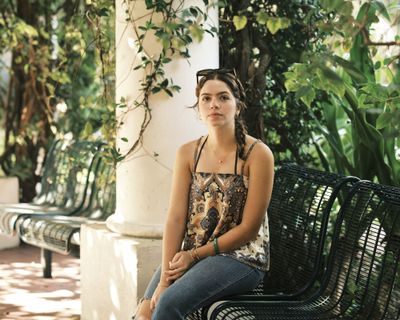These Parkland shooting survivors were promised visas. They’re still waiting

COCONUT CREEK, Fla. – On Valentine’s Day 2018, Bruna Oliveira’s geography teacher was shot dead at her feet as he ushered students into his classroom to shield them from an approaching gunman. Crouched near his body, holding her breath, the girl feared she would be killed next – dead at 14. But the shooter moved down the hallway on his rampage.
When the massacre at Marjory Stoneman Douglas High School in Parkland, Florida, occurred, Oliveira’s Brazilian family was living temporarily in the United States with no intention of staying. Her mother, an architect enrolled in an English immersion program, had brought her two children along on her student visa.
But the worst high school shooting in U.S. history made Oliveira an American, or a would-be American. It was a baptism by bullet, not just for her but also for scores of other immigrant and international students at her school. Many had fled their homelands to escape violence, and now their journey was turned on its head. While their horrified relatives urged them to return to their native countries, the teens, bonded by trauma, dug in their heels.
“It was a massive event that took a real toll on us, but it also, like, truly bonded us forever – to each other and to this country,” said Oliveira, now a premed college senior who aspires to be an emergency medicine doctor because of her experience.
Advised that the government offers a special visa to victims of serious crime who are helpful to law enforcement, Oliveira and 74 other survivors of the massacre applied for what is known as a U visa.
Little did they know then that the well-intentioned U visa program is among the most dysfunctional in the whole troubled immigration apparatus, with benefits far more delayed than those of the notoriously backlogged asylum program.
During this campaign season, debate on the volatile issue of immigration has focused on unauthorized crossings at the Southwest border. But many already in this country are thwarted when they try to play by the rules, and the little-known U visa program serves as a potent example of just how broken the system has become.
Created by Congress 24 years ago with overwhelming bipartisan support, the visa was meant to encourage immigrants living in the country without legal permission who were fearful of deportation to report crime; it was double-billed as a law enforcement and a humanitarian tool. But, underestimating the prevalence of serious crime and the dearth of other pathways to legalization, lawmakers imposed an annual cap of 10,000 visas that now undermines the program’s intended purpose.
With three times as many applicants most years, a backlog has mushroomed.
U visa applicants today will wait an average of five years for work authorization and as long as 20 years for the visa itself. In comparison, an asylum-seeker generally secures working papers in seven to eight months, and cases wend their way through immigration court in about four years.
If the U visa system worked as Congress had intended, Oliveira and the other Parkland survivors would possess not only U visas but green cards by now.
Instead, they are inching forward on a slow-moving queue alongside not only hundreds of thousands of victims of domestic violence, rape and armed robbery but also other survivors of the nation’s growing number of mass shootings – including the 2017 attack at a music festival in Las Vegas and the 2019 shooting at a Walmart in El Paso, Texas.
A Rush of Applications
From the outset, the U visa program was stymied.
It took the government eight years after Congress created the program to begin issuing the visas, and only then after prodding by lawsuits. This set a precedent; the U visa has spawned a cottage industry of litigation.
Initially, applicants got both employment authorization and visas swiftly, and many were able to report their assailants, help get them prosecuted, find legal work and kick-start newer, safer lives.
As word spread, though, the number of applicants exploded. Ten years ago, some 46,000 immigrant crime victims had pending applications; as of June, 229,568 did (along with 152,109 of their close family members).
That is partly because over time, many people who live under the radar get victimized in their neighborhoods and workplaces.
Christopher M. Casazza, a Philadelphia immigration lawyer, said that at least half of his 1,000 U visa applications involve armed robberies.
“A lot of my clients get paid in cash, and they’re like walking ATMs, or they get held up working the register at gas stations and convenience stores,” he said. “If there wasn’t a U visa to protect them, they wouldn’t cooperate with the police.”
Sometimes, it is the police who will not cooperate by completing forms that verify applicants’ claims about reported crimes. Participation is discretionary for law enforcement agencies unless they are in a state or city that has ordered them to comply. And even cooperative agencies can take so long to comply that delays pile on delays.
That is where the litigation comes in. Arguing that Congress intended for U visa applicants to get working papers within 60 days, lawsuits usually succeed in getting results for individuals. But they do not change the system.